Shared Legacy Farms Week 4 Newsletter, July 4-9, 2022
Farm Newsletter Week 4
July 4-9, 2022 | “B” Week
What’s in the Box this Week?
RAINBOW SWISS CHARD (1 bunch) ~ Swiss chard has expansive, pocketed leaves with stems in a spectrum of colors: red, white, green, yellow. It is actually in the beet family but doesn’t develop a bulb. Its leaves are more tender and delicate than other greens. Eat small leaves raw in salads and blanch or steam larger leaves. You can freeze chard for recipes later. To store: Keep dry, unwashed greens in a sealed plastic bag in the refrigerator up to 2 weeks. To prep: Wash leaves in basin of lukewarm water to remove grit. Remove the thicker stems by folding the leaves down the center and cutting out the stem. Stack several leaves on top of each other and slice into 1-inch wide ribbons. To freeze: Blanch washed greens for 2-3 minutes. Rinse in cold ice water to stop the cooking. Drain and freeze.
Download my Swiss Chard E-Book here to help you find recipes. Add uncooked greens to a mixed green salad. Steam stem pieces 8-10 minutes, and leaves 4-6 minutes. Or sauté greens until tender in a large sauté pan with olive oil, a pinch of salt, and garlic or onion. Watch for color to brighten as this signals they are done. Serve cooked chard alone as a side dish or use them in soup or with pasta, beans, rice, or potatoes. Chard also goes great in stir-fries or in any recipe calling for spinach.
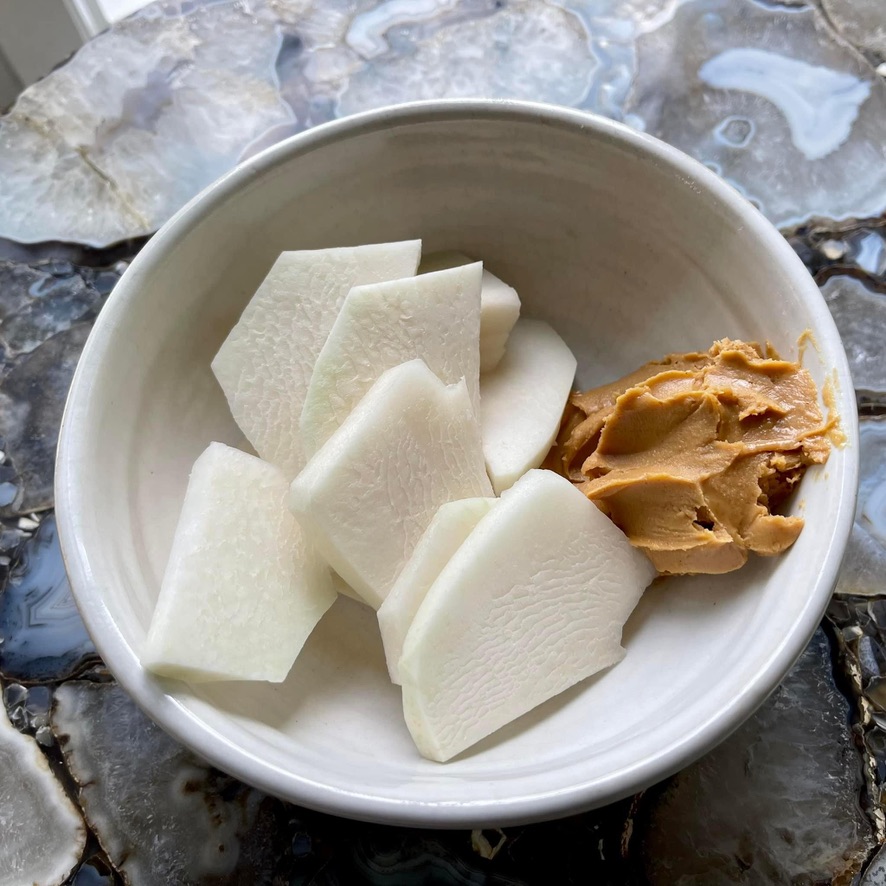
This is Farmer Kurt’s favorite way to eat kohlrabi. Raw with peanut butter. Try it!
PURPLE KOHLRABI with tops ~This plant was developed by crossing a cabbage with a turnip! The edible part of the plant is an enlarged section of the stem that develops just above the ground. It has a crisp interior like a potato. Store kohlrabi globe and leaves separately. The bulb will last for 2 weeks refrigerated in a plastic bag. Wrap leaves and stalks in a plastic bag and keep in the crisper drawer of the refrigerator. To prep: Rinse under cold running water just before use. Cut the outer skin off with a knife. Trim off the remains of the stalks and root. Grate, slice, or chop as desired. To cook: Cut raw kohlrabi bulb into sticks for a refreshing addition to a raw vegetable tray or grate it for salads. Try raw kohlrabi smeared with peanut butter. Lightly boil, steam or bake it, or add it to stews and stir-fries. Young kohlrabi leaves can be used in recipes calling for greens. To freeze: Cut into cubes or slices and blanch for 3-4 minutes. Place into ice water bath to stop the cooking. Drain and dry. Place in Ziplock freezer bag.
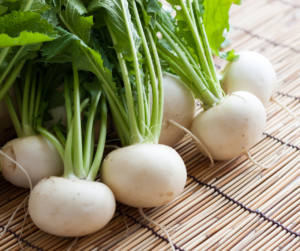
BUNCHED PARSLEY ~ For short-term storage, stand upright in a container with an inch of water. Then cover the herbs loosely with a plastic bag and refrigerate for up to 2 weeks. To prep: Chop the leaves and stem before cooking. The stem can be used to flavor soups and stews too. To dry: Place a piece of paper towel on a glass plate. Layer the parsley evenly around the plate being sure not to overlap. Cover with another piece of paper towel. Microwave on high for 1 minute. Leaves will be dry. Crinkle them with your finger and place them in a dry container, such as a Mason jar with a lid. To freeze: Chop parsley finely and freeze in ice cube trays with water. Pop out frozen cubes and freeze in a freezer bag.
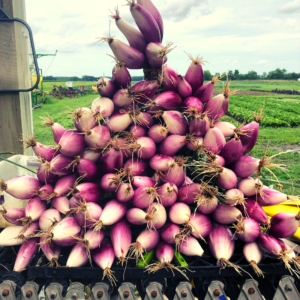
Tropea Onions look like torpedos
LONG RED TROPEA ONIONS (1 bunch) ~ These onions are often called “torpedoes” at our farm, due to their torpedo-like shape. Because they are not cured, these fresh onions will need to be stored in a plastic bag in the fridge and use within 2 weeks. To prep: Peel the onion’s skin and cut off the roots and top. To freeze: Cut or slice onions to desired size and place in freezer Ziplock bag. Remove all the air and seal. It helps to freeze them in 2-3 cup increments.
CUT LETTUCE (10 oz) ~ Store unwashed lettuce in a Debbie Meyer Green bag or Tupperware FridgeSmart container in the refrigerator. To store lettuce that you have already washed and dried with a spinner, place back in a plastic bag with a dry paper towel in the bag, and place the package in the vegetable crisper bin. Use within 4 days. To prep: Wash leaves in a basin of cold water. Dry in a salad spinner. To freeze: Not recommended.
BOOM SALAD MIX (12 oz) ~ This lettuce mix has a little bit of a kick. Store unwashed lettuce in a Debbie Meyer Green bag or Tupperware FridgeSmart container in the refrigerator. To store lettuce that you have already washed and dried with a spinner, place back in a plastic bag with a dry paper towel in the bag, and place the package in the vegetable crisper bin. Use within 4 days. To prep: Wash leaves in a basin of cold water. Dry in a salad spinner. To freeze: Not recommended.
WEEK #4 ADD-ON SHARES: We are Week “B”
Odd-numbered weeks of our CSA season (week 1,3,5) are called “A” weeks. And even-numbered weeks (week 2,4,6) are called “B” weeks. If you have any kind of non-veggie, bi-weekly share, you have been assigned to either “A” or “B” week for the season. If you get a cheese share, it always comes on Week “A.”
WEEK 4 FRUIT SHARE:
RED CURRANTS (HALF PINT) certified organic ~ (from Wayward Seed Farm, Fremont) To store: Store in the fridge. Do not wash until you eat them. These will last about 3-4 days. To prep: Rinse and remove stems. To freeze: Remove stems and lay flat inside a Ziploc freezer baggie. Pop into freezer.
BLUEBERRIES (PINT) ~ To store: Store blueberries in the refrigerator for up to 5 days. Use a vinegar bath to kill off bacteria and lengthen their shelf life. To prep: Rinse gently just before using. To freeze: Choose ripe berries. Wash and sort out the mushy ones. Let dry in colander for 10 minutes. Place them in an even layer on a large cookie sheet (with a lip) or any container you may have and put in freezer overnight until frozen. Then pack them into a freezer bag, removing the air, and seal.
SWEET DARK CHERRIES (1 lb. pouch) ~ (from Quarry Hill Orchard, Berlin Heights) Sweet cherries will be either a dark red color, or a red/yellow blush color (the Rainier cherry) and are best for eating out of hand. Sour cherries are usually a bit soft, and are best used in baking pies or cobblers. Store cherries in your refrigerator in a plastic, perforated bag in the crisper drawer for up to a week. To prep: Remove stem. Pit the cherries after washing. To freeze: Choose firm, ripe cherries. Pit cherries first (although you don’t have to). Flash freeze on a sheet pan. Then pop into a Ziplock bag. Freeze for up to a year.
Ice Cream Flavor of the Week:
PEPPERMINT CHOCOLATE CHUNK from Knueven Creamery. Note: be sure to stop and pick up your ice cream from the Knueven milk truck at your pickup site! They will be located either right before or after your veggie pickup. Your farmers will not be passing this out in their delivery line.
Coffee Flavor of the Week:
TANZANIA PEABERRY: Maddie & Bella Coffee Company ~ medium body, rich, uncommonly fruity
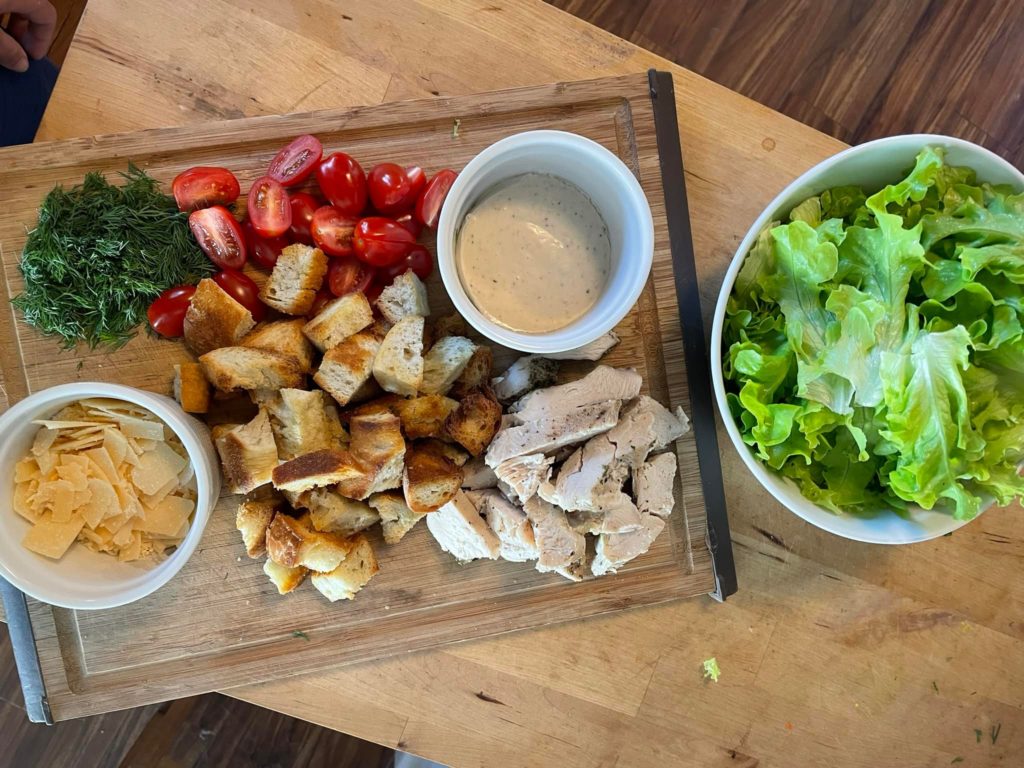
A Salad Board is a great way to use up veggies that are starting pile up in the fridge.
Use Your Veggies to Make a Salad Board
Salad Boards are a great way to make use of your lettuce and veggies that are piling up in your fridge. My boys love charcuterie board dinners, and Salad Boards are another twist on this classic that allow your guests to have a little fun and turn Salad Night into an event. Here are some tips for how to build a fun Salad Board dinner night.
Consider choosing a theme: Either go basic with classic salad ingredients or get creative and build a theme. Greek salad, Taco, Italian, Seafood, Cobb Salad, Mediterranean, Caprese, Asian, Caesar.
- Start with your base greens. We recommend using a basic lettuce, plus some other type of exotic green (chopped up kale is my standard go-to. Massage it with a little bit of olive oil). If you have some herbs like parsley or cilantro, those can be a fun addition.
- Add your protein. Think shredded or cubed chicken, egg, salmon, grilled flank steak, bacon, black beans.
- Include classic vegetables like tomatoes, cucumbers, sliced peppers, carrots, grilled corn. I like to create little piles on the board (or put them into mini cups if they’re a little runny). Pay attention to color.
- Add some cheese: Mexican, feta, cotija, cubed cheddar cheese, goat cheese, hot pepper cheese for a kick.
- Add some crunch or flavor zing: homemade croutons, sesame seeds, sunflower seeds, nuts, tortilla strips, crispy wontons, Chinese noodles or Ramen noodles, roasted chickpeas. If you’re going more for a marinated flavor zing, add some pickles, olives, artichokes, or lacto-fermented veggies like kimchi!
- Consider some fruit if it fits the flavor profile: blueberries, oranges, pears, apples, pomegranate seeds, avocado, or dried fruit like cranberries
- Prep the dressing: Create a bowl of your own dressing on the side. Or use your favorite bottled versions like Garlic Expressions, Caesar, Ranch, Blue Cheese….
- Don’t forget the bread! We like to add some good bread to go with the salad, like a baguette or loaf of sourdough.
To assemble, place some of the toppings and dressing options in the small bowls and pile other ingredients like lettuce, diced, or sliced vegetables on a board or platter. Use tongs to make it easy for everyone to serve themselves.
Download my one page DIY Salad Board Guide here!
Watch CSA Coach Cadie Jardin’s recent video that shows you how to build a Salad Board.
Use the leftovers and build a Mason Jar salad! Throw the protein on the base of the jar. Add a little bit of the dressing on top of the protein. Then add the heartier vegetables like cucumbers, and olives. Then throw on the cheese and top with lettuce and greens. Crunchy stuff goes on top, and then store it in the fridge for up to 2 days. It’s an easy and delicious lunch for the next day.

Jed helps Kurt lay irrigation pipe. These pipes are moved by hand and locked together.
FARMER KURT’S FIELD NOTES
This week, I set up PART 1 of my irrigation plan. It’s been pretty hot and dry all week. Every year around this time, I set up my irrigation network of lay pipe, drip tape, overhead sprinklers, and aluminum pipe. It’s a pretty big process, and it involves a lot of mapping and planning. Once I set up the main lines, these stay there permanently for the rest of the season. I spent the first half of the week using my irrigation reel and sprinkler gun watering the sweet corn and melons.
I also used a whole day to water my acre of cover crops… Corinna thought that was kind of weird. “Why aren’t you watering the veggies?” she asked. I explained that my cover crops are just as important as my cash crops because I need to build soil health, too. I spent Wednesday pushing water over the cabbage, broccoli, tomatoes, and peppers. These will eventually get drip irrigation set up next week, but I needed the soil to be wet, so I could more easily install that system later. And finally, yesterday I set up the lay hose and drip lines for the winter squash, summer squash, and cucumbers. They got a nice drink before the rains came Friday night — about a half inch.
I always say the best way to make it rain is to spend 3 days setting up your irrigation system. Works like a charm.
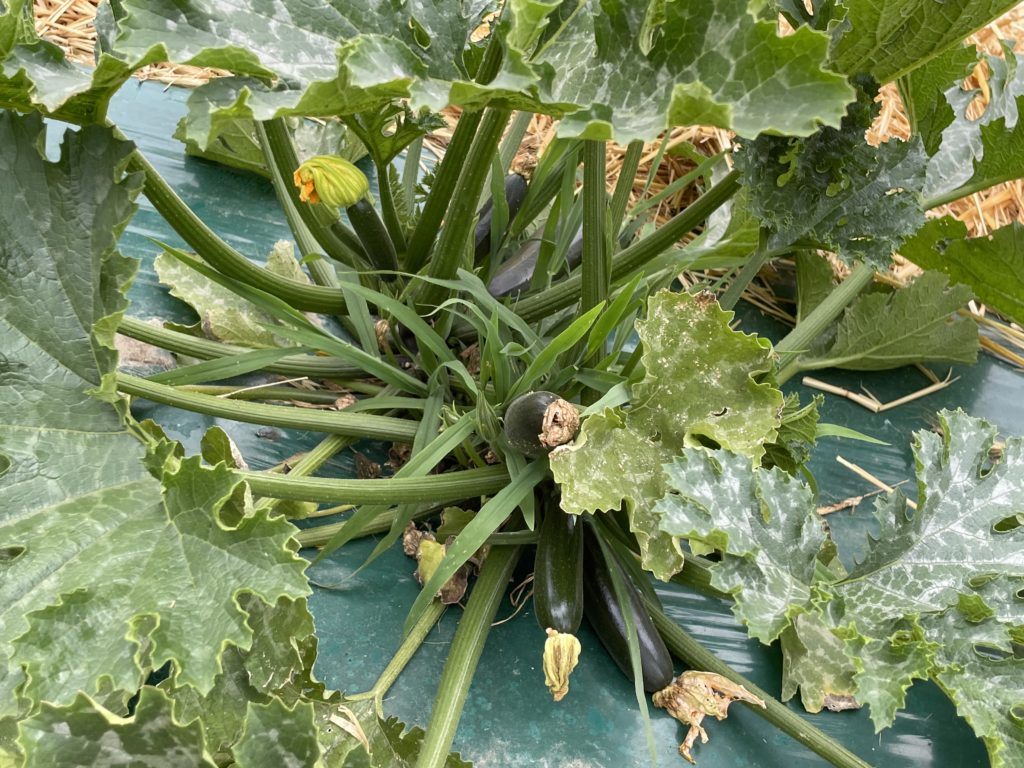
The zucchini plants look very healthy, but the fruit hasn’t been growing as fast as it usually does.
Noah and John finished seeding the fall transplants for the greenhouse. My greenhouse tables are full once again. Those are the broccolis, the cauliflowers, the cabbages for later in the fall. I can’t believe how fast the season is going. It’s already week 4 out of 18. Gotta be thinking about the future succession crops all the time.
The summer squash (yellow squash and zucchini) plants look really strong and healthy. They are loaded with fruit, but they’re not growing as fast as I like. I suspect it may be that they are thirsty. So I just gave them a nice long drink yesterday, and I’m hoping that will tip them over the edge and get them to start shucking out.
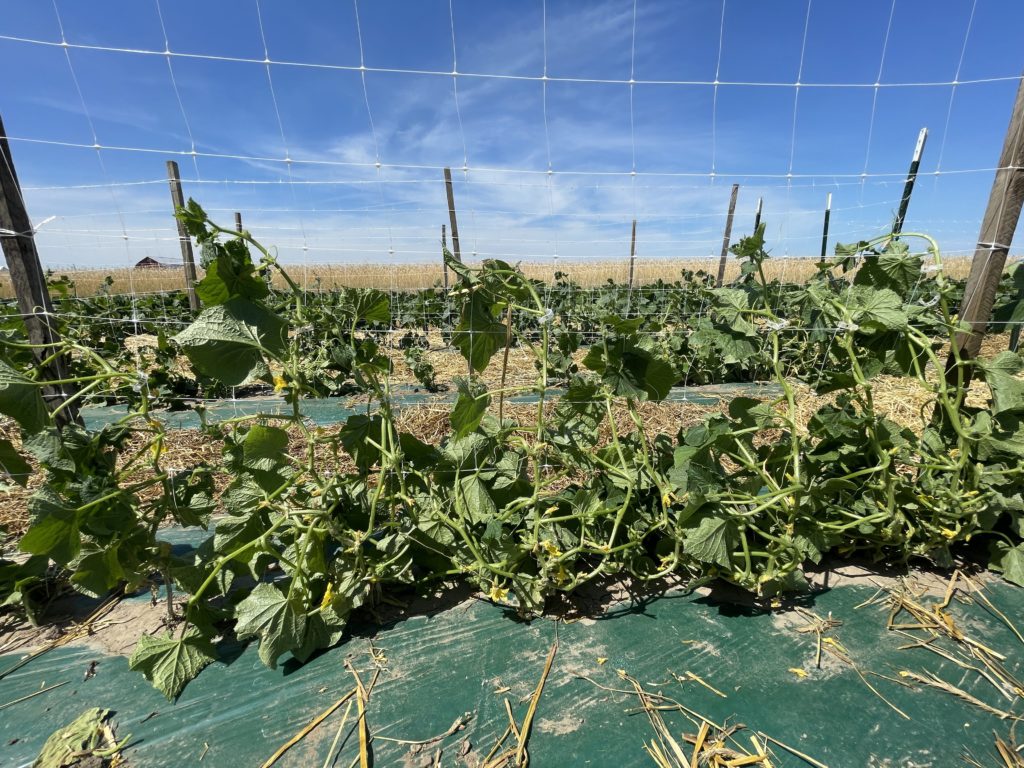
The cucumbers are trellised to a netting. They will climb the netting and the fruits will hang from the vine. Keeping them off the ground supposedly encourages plant health and greater yield.
The big job on the farm this week was trellising the cucumbers. This is the first time we have ever trellised them. It’s actually a common form of growing them in other CSA’s, so I decided to try it. According to other farmers, it will significantly increase our yields and create healthier plants. Keeping the fruit off the ground will minimize plant disease and pest issues too. I’m excited to see if it works. I should know in about 2 weeks. My crew spent a lot of man-hours on this project, so I have a lot of labor cost into this. But it was really cool to see how my guys took ownership. We were all pulling up YouTube videos to try and figure out the best way to do it.
I lost a crop of radishes, turnips and Tokyo Bekana greens to weeds. Not to worry. I’ve got plenty of other stuff in the pipeline, and I plan for these kind of losses. It’s part of the farm life, but it’s still hard to see that seed go to waste. Sometimes it’s just not worth the labor expense to weed the beds, so you have to let it go.
Corinna and I celebrated our 15th wedding anniversary this week. We got all dressed up (she wore a pretty sun dress), and I took her out to Benchmark at Levis Commons on Friday night, where we had a phenomenal steak dinner. (The whiskey sour was also top notch). Thanks for the restaurant suggestion. I’ve had a lot of you tell me about that place. I met the chef and he knew my parents. He said they make the best sweet corn he’s ever had, and then he apologized for the fact that our corn salad wasn’t using our sweet corn. It made me laugh.

The sweet corn tassels sway in the wind and blow their pollen down below where it can fertilize the ears.
Speaking of sweet corn, the first crop is tasseling! We should have our first corn in about 3 weeks. The timing of that will be tricky. Corinna and I had wanted to take the last week of July to go on a vacation with the boys to the OshKosh Air Show. We were going to “pause” the CSA for that week so we could do it. But I’m not sure how that’s all going to work. That happens to be the same week my parents are taking off to go to my cousin’s wedding. And it will likely be the first week of sweet corn and when everything is bursting out of the ground. So someone will need to be here to manage the farm. Corinna and I are trying to figure out if we can actually physically leave the farm to take that vacation, or if we’ll need to modify our plan. Maybe we WILL keep the CSA running, and see if our team can run the week without us. Maybe we’ll just leave for 4 days and shorten our trip. It remains to be seen. I’ll keep you posted.
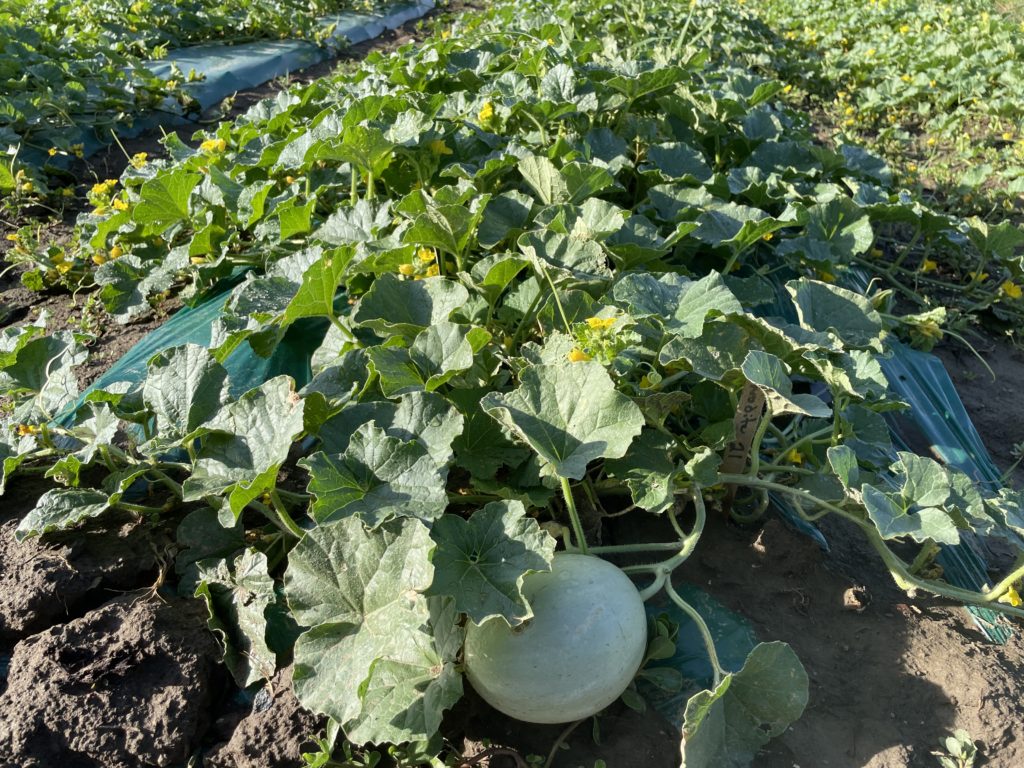
Can you see the melon beginning to form? These require a lot of water.
I hope you have some fun Fourth of July plans this weekend! I’m taking the family to one of my old college friend’s house this Sunday in Bucyrus. We’ll spend the day playing in the pond and then camp out on their lawn in our tent. Then we’ll scoot back home on Monday morning to celebrate our big “Turnow Family Reunion” on the Fourth of July. My boys love to play in their pond all day too. It will be swim fest for the Benches!
Uncle Torsten (Corinna’s brother) arrives this coming Thursday and is staying for 2 weeks! If you come to the Elmore farm to pick up veggies, you’ll see his Scamp trailer in the grass. The boys are incredibly excited, and have all kinds of plans for him. Corinna’s dad shows up NEXT weekend for 3 days. He hasn’t visited our farm in 8 years. We are really looking forward to spending time with him.
~Your Farmer, Kurt
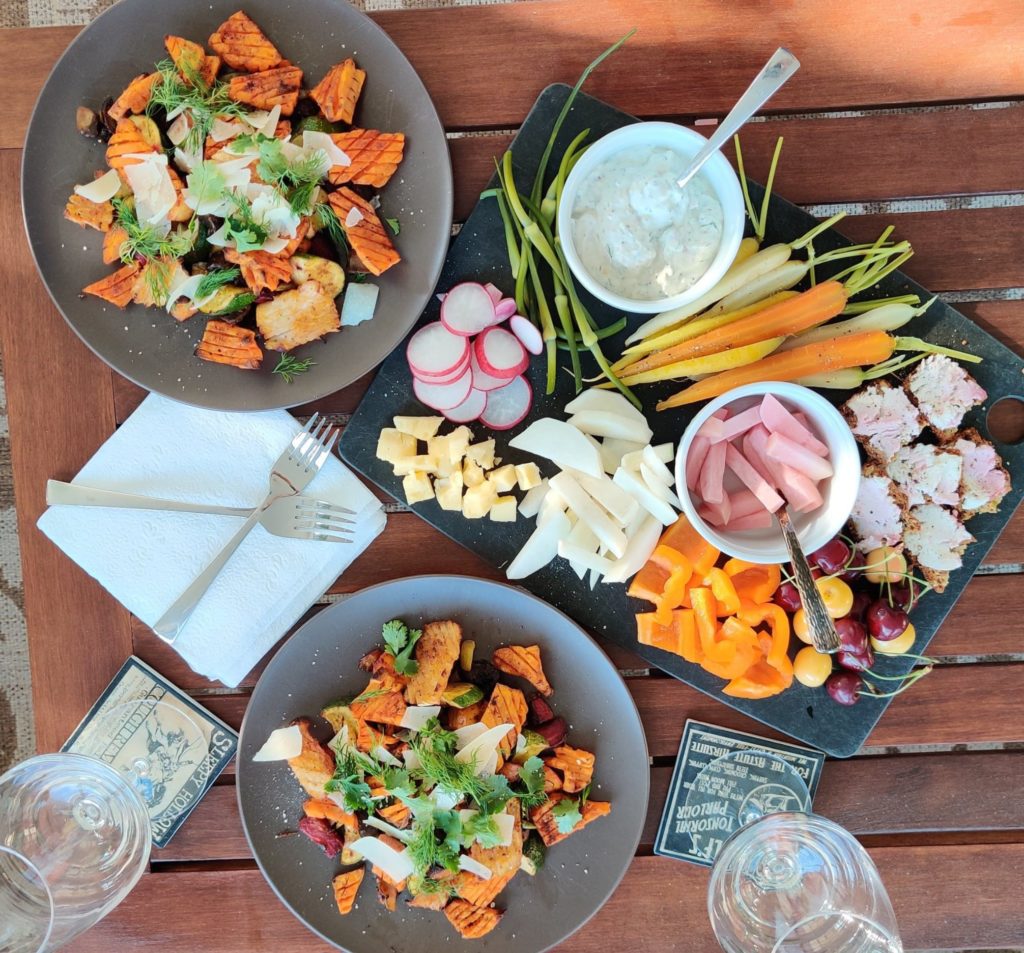
Clara Eckel made some Kohlrabi waffle fries this week.
WEEK 4 ANNOUNCEMENTS
Our NEXT CONTEST is underway!! Play SLFarms Bingo with us this month!
From June 26 – July 20, you are encouraged to compete in our SLF Bingo Board competition. To play, download a copy of this PDF file of the Bingo Board. Fill in as many of the boxes as you can over the next 3 weeks! Some of them are EASY (you may already have done them), and some are little more challenging.Once you complete 20 of the 25 spots, post a picture of your Bingo board in our Facebook group with the hashtag #CSABingo2022. I’ll choose 3 random winners from this pool of submitted boards on July 21st, and you’ll receive a $50 gift package of flavored olive oils from the OliveScene.com.- Watch our weekly Live Unboxing video this Tuesday around 8 PM inside the private Facebook group. Cadie Jardin, our CSA coach and dietitian, will show you what’s in the box, share storage tips and ideas for how to use your product. You can find the Facebook group at this link. If you aren’t on Facebook, we download the unboxing video into the digital Academy library (which you all get free access to). Reach out to me if you can’t figure out how to get into the Academy. (www.sharedlegacyfarms.com/academy) — note: you should NOT pay for a membership to the Academy. You get in for free with your membership!
- You can order additional items from the Shared Legacy Farms online store. Our store link is super easy to remember: www.sharedlegacyfarms.com/store. Just be sure to select the right pickup site that coincides with your pickup location. If the pickup option is greyed out or not available, it means you missed the window to order. You need to place your order 36 hours before your site. We harvest the product on Monday and Wednesday mornings — early. This week, the store will have: Boom Salad Mix (12 oz), carrots, Hakurei turnips, white scallions, parsley, curly kale, dinosaur kale, white kohlrabi, garlic scapes, gooseberries (1/2 pint), and black currants (1/2 pint), dark red cherries (1 lb), blueberries, along with local maple syrup, rye flour, and a few extra eggs from Jed/Josiah.
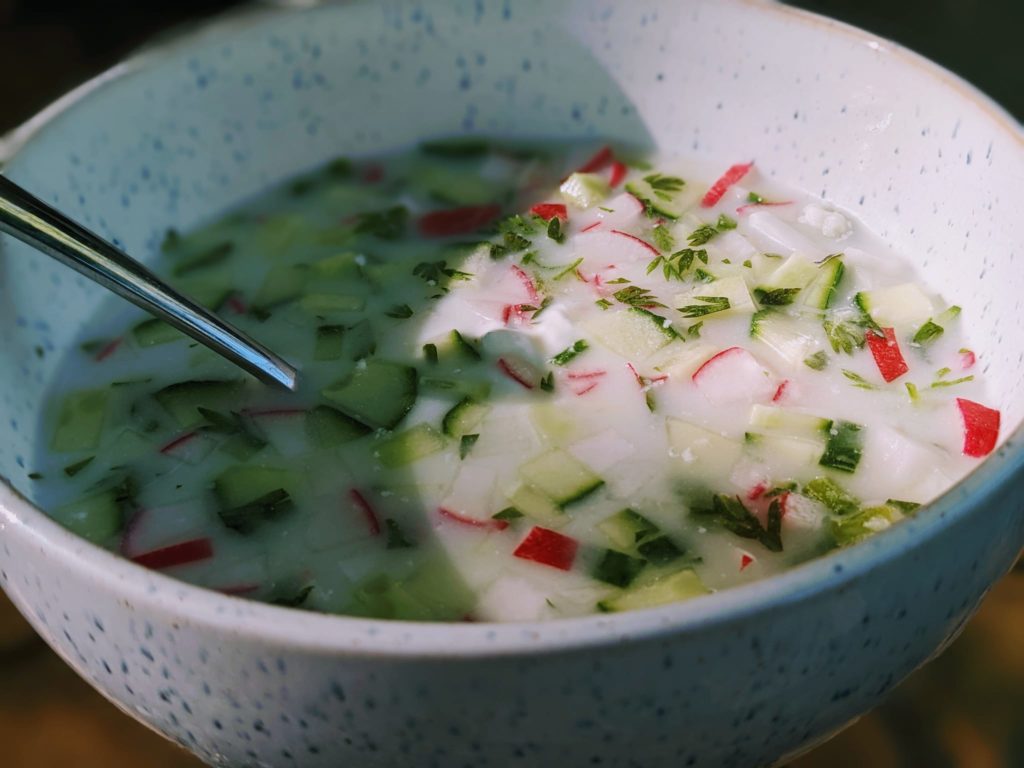
Lindsey Simpson shared this recipe idea for a chilled cucumber/radish/dill soup called Okroshka from Ukraine.
WEEK 4 CSA RECIPES
Members: You can download these recipes as a PDF here. These recipes are designed to inspire you to use your box this week! Please check inside our private Facebook group to find your fellow members sharing ideas for what to make with their box! Share a photo and you might be featured in next week’s newsletter!
- Easy Swiss Chard
- Garlicky Swiss Chard and Chickpeas
- Tropea Onion Jam
- Spaghetti with Tropea Onions
- Glazed Hakurei Turnips
- Miso Roasted Turnips
- Kohlrabi Fries
- Kohlrabi Carrot Fritters with Avocado Cream Sauce
- Chimichurri Sauce
- Red Currant Jam
- Red Currant Crumb Bars
- Cherry Berry Crisp
- Blueberry Raspberry Muffins

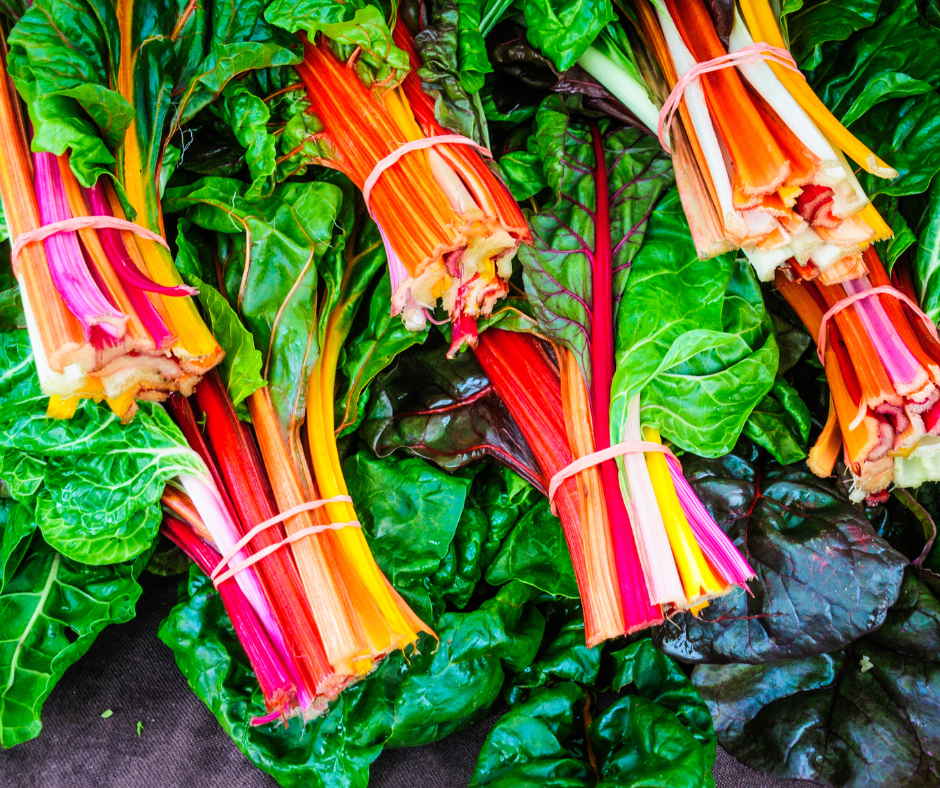
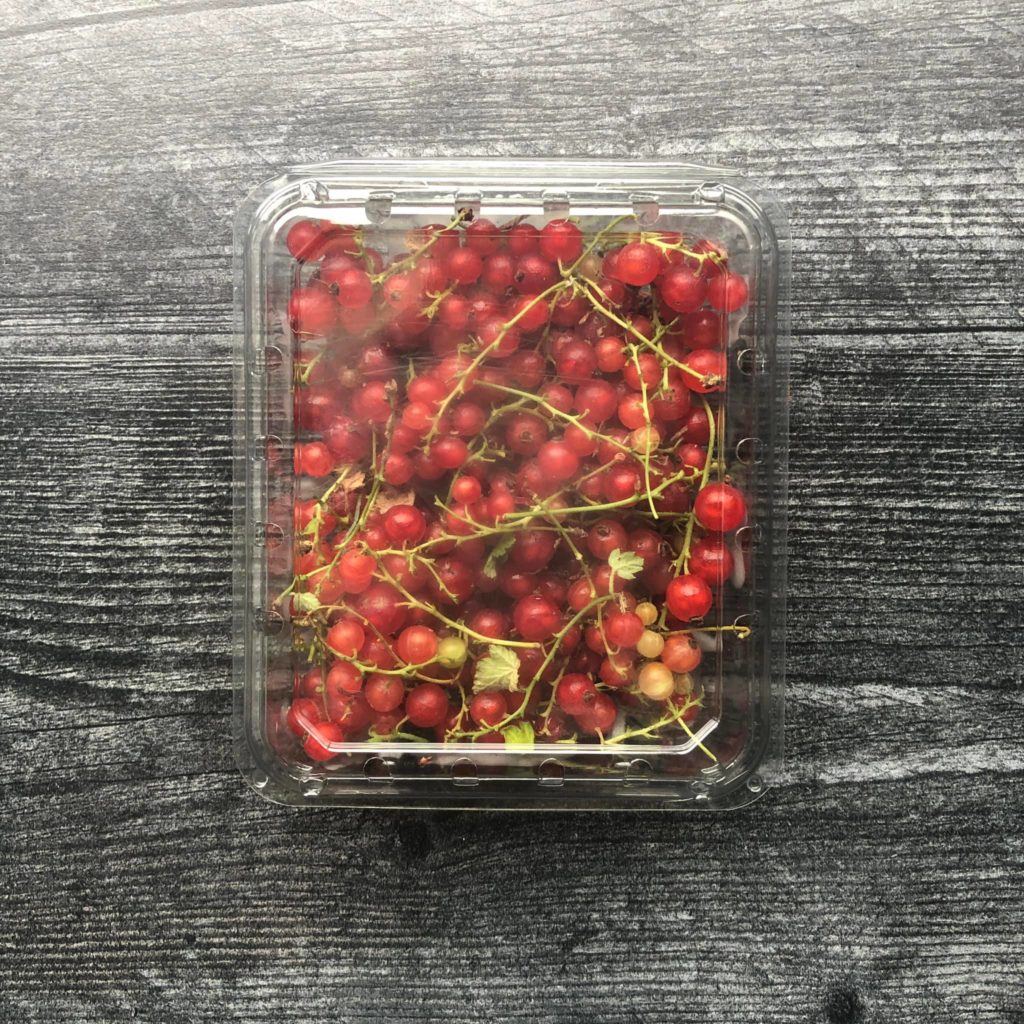
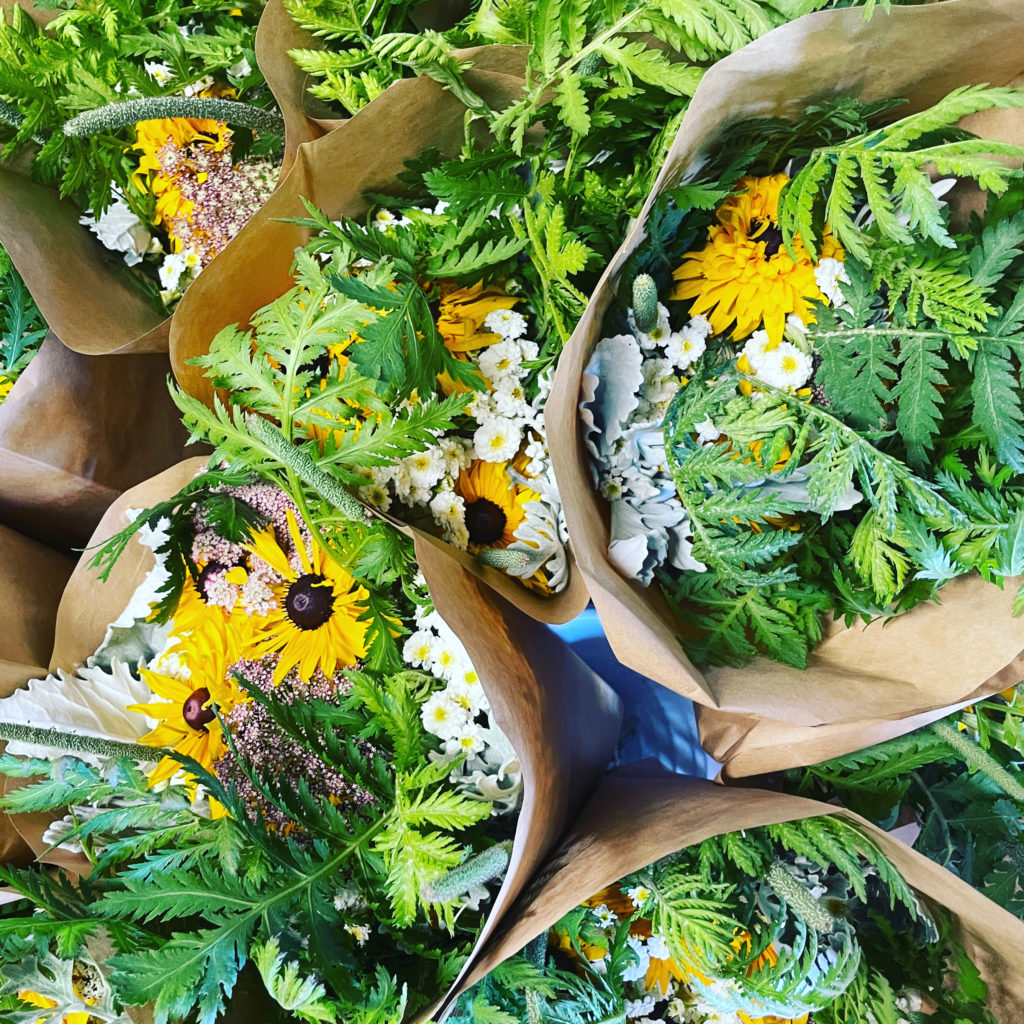
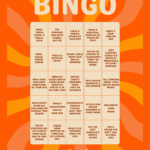 Our NEXT CONTEST is underway!! Play SLFarms Bingo with us this month!
Our NEXT CONTEST is underway!! Play SLFarms Bingo with us this month!